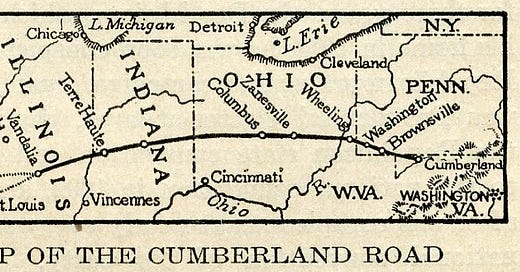My wife and I were recently traveling in the northeastern United States and every so often we noticed signs for Route 40. Having grown up in central Ohio, all I knew about Route 40 was that it was known as Main Street in the Columbus area. I also knew it was called The National Road, but not sure why. When my wife and I saw some Route 40 signs in other states, it struck our interest and we started talking about why it was called the National Road.
After talking about it a little bit, we sound found that neither one of us really knew where the name came from, so we looked into it further and found some interesting and historical information. After looking up some web sites and reading over the information, I decided to post some of the information we found.
This route was authorized by Congress in 1806 during the Thomas Jefferson Administration for the purpose of reaching the western settlements from the East Coast. It began in Cumberland, Maryland in 1811 and ran toward the Ohio River.
Route 40 was the first road built entirely with federal funds and the chosen path sometimes followed American Indian or early settlers’ trails or military roads dating back to the French and Indian War.
By 1818 the road had been completed to the Ohio River at Wheeling, which was then in Virginia. Eventually the road ran through central Ohio and Indiana reaching Vandalia, Illinois in the 1830's where construction ceased due to a lack of funds.
The federal government funded construction for the road but later conveyed part of the road's responsibility to the states through which it runs for operational costs. States then built tollhouses (those dreaded tolls we still have in places) to help cover the costs of maintaining the road, although the federal government still had the responsibility for road repairs.
In the 20th century with the advent of the automobile, the National Road was connected with other historic routes under the title National Old Trails Road which would extend further east to New York City and west to Los Angeles, California. These were extensions and not all part of the original Route 40. Today, much of the alignment is followed by U.S. Route 40 (US 40) with various portions bearing the Alternate U.S. Route 40 (Alt. US 40) designation, or various state-road numbers. Thus, the reason we would see Route 40 signs in various areas and states.
In 1976, the American Society of Civil Engineers designated the National Road as a National Historic Civil Engineering Landmark. In 2002, the entire road, including extensions east to Baltimore and west to St. Louis, was designated the Historic National Road, an All-American Road.
So, after reading more about the National Road, we found it very interesting reading about all the history involved in this route. I think next trip may be a little off the main path while we look for some of the historic sites and markers along the way of the National Road.
References used and for further information:
https://en.wikipedia.org/wiki/National_Road
https://www.nps.gov/articles/national-road.htm
https://highways.dot.gov/highway-history/general-highway-history/back-time/national-road
https://hti.osu.edu/sites/hti.osu.edu/files/the-national-railroad4.pdf






Interesting...I just taught a history lesson on this to my community college class.